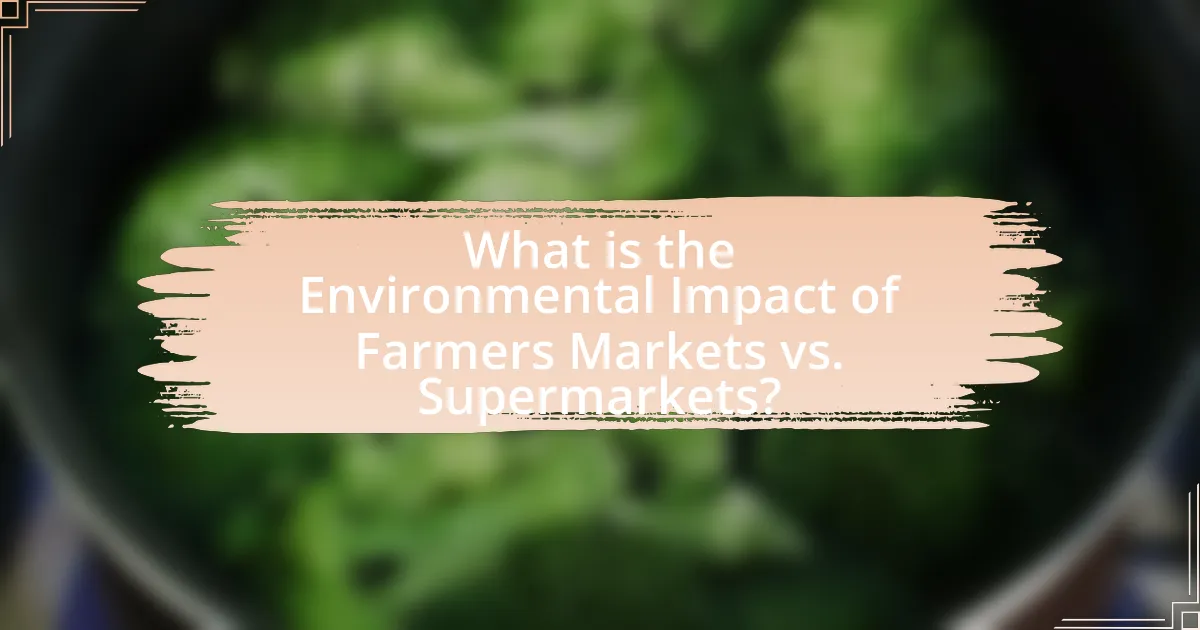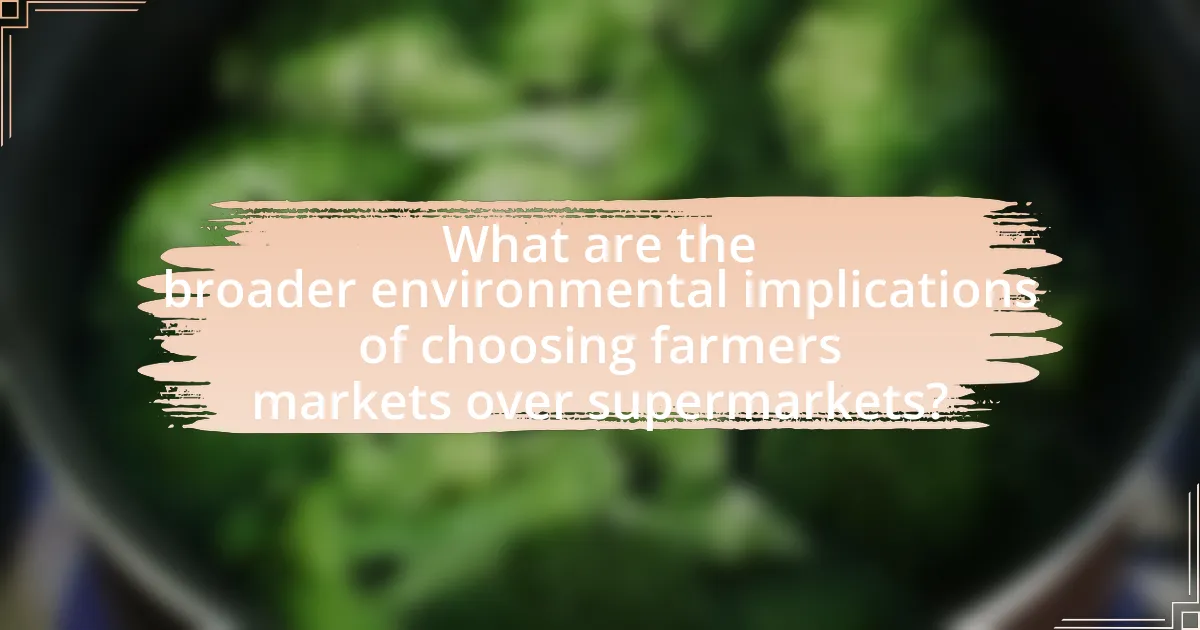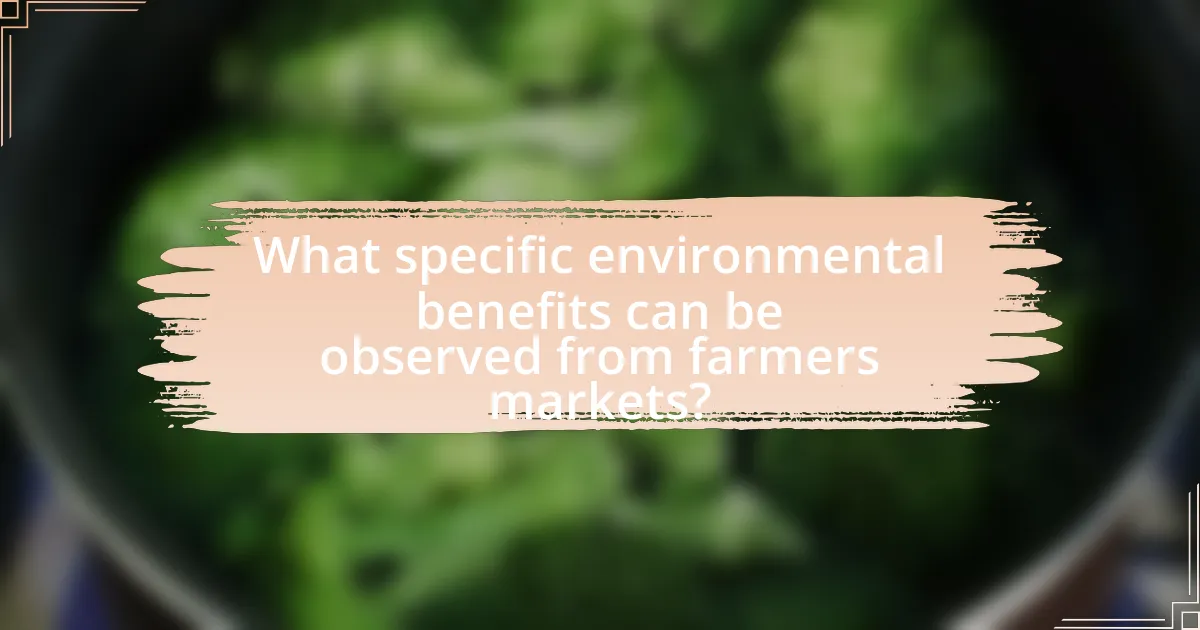The article examines the environmental impact of farmers markets compared to supermarkets, highlighting that farmers markets generally have a lower carbon footprint due to reduced transportation emissions and support for local agriculture. It discusses the sustainable practices promoted by farmers markets, such as local sourcing and minimal packaging, which contribute to enhanced biodiversity and soil health. In contrast, supermarkets often rely on industrial agriculture and long-distance transportation, leading to higher greenhouse gas emissions and waste. The article also addresses the challenges faced by farmers markets and the barriers consumers encounter in accessing them, while emphasizing the importance of consumer choices in promoting sustainability.

What is the Environmental Impact of Farmers Markets vs. Supermarkets?
Farmers markets generally have a lower environmental impact compared to supermarkets. This is primarily due to reduced transportation emissions, as farmers markets often feature local produce, minimizing the distance food travels from farm to consumer. A study published in the journal “Sustainability” found that local food systems can reduce greenhouse gas emissions by up to 25% compared to conventional supermarket supply chains. Additionally, farmers markets typically promote sustainable farming practices, which can enhance soil health and biodiversity, further mitigating environmental degradation. In contrast, supermarkets often rely on large-scale, industrial agriculture, which can lead to higher carbon footprints and resource depletion.
How do farmers markets and supermarkets differ in their environmental practices?
Farmers markets typically have more sustainable environmental practices compared to supermarkets. Farmers markets often prioritize local produce, which reduces transportation emissions and supports local economies, while supermarkets frequently source products from distant locations, increasing their carbon footprint. Additionally, farmers markets usually have less packaging waste, as many vendors encourage customers to bring their own bags or containers, whereas supermarkets often rely on plastic packaging for products. Studies indicate that local food systems, such as those represented by farmers markets, can reduce greenhouse gas emissions by up to 25% compared to conventional supermarket supply chains.
What are the sourcing methods used by farmers markets?
Farmers markets primarily source their products through direct relationships with local farmers and producers. This method allows them to offer fresh, seasonal produce while supporting local agriculture. By prioritizing local sourcing, farmers markets reduce transportation emissions and promote sustainable farming practices, which contributes positively to the environment. Studies indicate that local food systems, such as those utilized by farmers markets, can significantly lower carbon footprints compared to conventional supermarket supply chains, which often rely on long-distance transportation and mass production methods.
How do supermarkets source their products and what are the implications?
Supermarkets source their products through a combination of direct relationships with manufacturers, wholesalers, and distributors, often prioritizing cost efficiency and supply chain optimization. This sourcing strategy can lead to implications such as reduced local agricultural support, increased carbon footprints due to long-distance transportation, and potential negative impacts on food quality and freshness. For instance, a study by the Food and Agriculture Organization indicates that food transported over long distances contributes significantly to greenhouse gas emissions, highlighting the environmental costs associated with supermarket sourcing practices.
Why is the location of food sources important for environmental impact?
The location of food sources significantly influences environmental impact due to factors such as transportation emissions, land use, and resource allocation. Proximity to consumers reduces the carbon footprint associated with transporting food, as longer distances typically result in higher greenhouse gas emissions. For instance, food transported over 1,500 miles can emit up to 17 times more carbon dioxide than locally sourced food. Additionally, the location affects land use practices; urban farming initiatives can utilize vacant lots, reducing the need for agricultural expansion into natural habitats. This shift can help preserve biodiversity and minimize habitat destruction. Therefore, the strategic placement of food sources is crucial for mitigating environmental degradation and promoting sustainability.
How does the distance food travels affect carbon emissions?
The distance food travels significantly affects carbon emissions, as longer transportation distances typically result in higher greenhouse gas emissions. For instance, transporting food over long distances often involves fossil fuel consumption, which contributes to carbon dioxide emissions. A study by the Food and Agriculture Organization (FAO) indicates that food miles can account for a substantial portion of a product’s total carbon footprint, with transportation contributing up to 11% of the total emissions for some food items. Therefore, reducing the distance food travels by sourcing locally can lead to lower carbon emissions and a smaller environmental impact.
What role does local food production play in sustainability?
Local food production significantly contributes to sustainability by reducing transportation emissions and promoting biodiversity. When food is produced locally, it minimizes the distance it travels from farm to consumer, which decreases greenhouse gas emissions associated with transportation. According to a study published in the journal “Environmental Science & Technology,” local food systems can reduce carbon footprints by up to 50% compared to conventional food systems. Additionally, local food production supports diverse agricultural practices that enhance soil health and ecosystem resilience, further contributing to sustainable environmental practices.
What are the waste management practices of farmers markets compared to supermarkets?
Farmers markets typically implement more sustainable waste management practices compared to supermarkets. Farmers markets often focus on reducing waste through practices such as composting organic materials, encouraging customers to bring reusable bags, and minimizing packaging. In contrast, supermarkets generate significant amounts of waste, primarily due to excess packaging and food spoilage, with studies indicating that supermarkets waste approximately 10% of their food inventory. Additionally, farmers markets often collaborate with local food banks to donate unsold produce, whereas supermarkets may have more rigid policies that limit food donation. These differences highlight the more environmentally friendly waste management approaches of farmers markets.
How do farmers markets handle food waste?
Farmers markets handle food waste primarily through donation, composting, and selling at discounted prices. Many farmers markets partner with local food banks and charities to donate unsold produce, which helps reduce waste while supporting community needs. Additionally, some markets implement composting programs to recycle organic waste, turning it into nutrient-rich soil amendments. Furthermore, vendors often sell items that are nearing the end of their shelf life at reduced prices to encourage sales and minimize waste. These practices collectively contribute to a more sustainable approach compared to traditional supermarkets, where food waste is often higher due to stricter aesthetic standards and larger quantities of unsold goods.
What waste reduction strategies do supermarkets implement?
Supermarkets implement several waste reduction strategies, including food donation programs, inventory management systems, and composting initiatives. Food donation programs allow supermarkets to partner with local charities to redistribute unsold but still edible food, thereby reducing waste while supporting community needs. Advanced inventory management systems help supermarkets track product freshness and optimize stock levels, minimizing overstock and spoilage. Additionally, composting initiatives convert organic waste into compost, which can be used for soil enrichment, further reducing landfill contributions. These strategies collectively contribute to a significant decrease in food waste, with some supermarkets reporting reductions of up to 50% in food waste through these practices.

What are the broader environmental implications of choosing farmers markets over supermarkets?
Choosing farmers markets over supermarkets generally leads to reduced environmental impacts, primarily due to shorter supply chains and lower carbon footprints. Farmers markets typically feature local produce, which minimizes transportation emissions compared to supermarkets that source products from distant locations. A study by the USDA found that local food systems can reduce greenhouse gas emissions by up to 25% compared to conventional food distribution methods. Additionally, farmers markets often promote sustainable agricultural practices, which can enhance soil health and biodiversity. This contrasts with many supermarket supply chains that may rely on industrial farming techniques, contributing to habitat loss and chemical runoff. Therefore, opting for farmers markets supports local economies while fostering environmentally friendly practices.
How do farmers markets contribute to biodiversity?
Farmers markets contribute to biodiversity by promoting the sale of a diverse range of locally grown crops, which supports genetic diversity within agricultural systems. By providing a platform for small-scale farmers to sell heirloom and non-commercial varieties, farmers markets encourage the cultivation of plants that may not be found in conventional supermarkets. Research indicates that diverse crop varieties can enhance ecosystem resilience, improve soil health, and reduce pest outbreaks, thereby fostering a more sustainable agricultural environment. Additionally, farmers markets often prioritize organic and sustainable farming practices, which further protect local ecosystems and promote biodiversity.
What types of farming practices are promoted at farmers markets?
Farmers markets promote sustainable farming practices, including organic farming, regenerative agriculture, and local sourcing. These practices focus on minimizing chemical inputs, enhancing soil health, and reducing transportation emissions. For instance, organic farming avoids synthetic pesticides and fertilizers, which aligns with environmental conservation efforts. Regenerative agriculture emphasizes practices that restore soil health and biodiversity, contributing to ecosystem resilience. Additionally, local sourcing reduces the carbon footprint associated with transporting food over long distances, further supporting environmental sustainability.
How does biodiversity impact ecosystem health?
Biodiversity significantly enhances ecosystem health by promoting resilience, stability, and productivity. Diverse ecosystems can better withstand environmental stressors such as climate change, diseases, and invasive species, as they possess a wider range of genetic, species, and ecosystem diversity. For instance, a study published in the journal “Nature” found that ecosystems with higher biodiversity are more productive and can recover more quickly from disturbances, demonstrating that biodiversity is crucial for maintaining ecosystem functions and services.
What are the effects of consumer behavior on environmental sustainability?
Consumer behavior significantly impacts environmental sustainability by influencing demand for products and practices that either harm or benefit the environment. When consumers prioritize sustainable products, such as organic or locally sourced items, they encourage businesses to adopt eco-friendly practices, thereby reducing carbon footprints and resource depletion. For instance, a study by the Journal of Cleaner Production found that consumers willing to pay a premium for sustainable goods can lead to a 30% reduction in greenhouse gas emissions associated with food production. Conversely, consumer preference for convenience and low-cost items often drives mass production and waste, contributing to environmental degradation. Thus, consumer choices directly shape market trends and environmental outcomes.
How does shopping at farmers markets influence local economies?
Shopping at farmers markets positively influences local economies by keeping money within the community and supporting local farmers. When consumers purchase goods directly from farmers, approximately 80% of the money spent remains in the local economy, compared to only 43% when shopping at supermarkets. This direct transaction fosters job creation, enhances local agricultural production, and encourages sustainable practices. Additionally, farmers markets often provide a platform for small businesses and artisans, further diversifying the local economy and promoting economic resilience.
What are the environmental benefits of supporting local farmers?
Supporting local farmers provides significant environmental benefits, including reduced carbon emissions, enhanced biodiversity, and improved soil health. Local food systems typically require shorter transportation distances, which lowers greenhouse gas emissions associated with food transport. According to a study by the USDA, food transported over long distances can generate up to 11 times more carbon emissions than locally sourced food. Additionally, local farming practices often promote crop diversity, which supports ecosystems and wildlife, as diverse crops can provide habitats for various species. Furthermore, local farmers frequently employ sustainable agricultural practices that enhance soil health, such as crop rotation and organic farming, leading to better water retention and reduced erosion. These practices contribute to a more resilient agricultural system and mitigate the negative impacts of industrial farming on the environment.

What specific environmental benefits can be observed from farmers markets?
Farmers markets provide significant environmental benefits, including reduced carbon emissions, minimized food waste, and enhanced biodiversity. By sourcing food locally, farmers markets decrease the distance food travels, which lowers transportation-related emissions; studies indicate that local food systems can reduce carbon footprints by up to 50%. Additionally, farmers markets often feature seasonal produce, which helps prevent food spoilage and waste, as local farmers can sell surplus directly to consumers. Furthermore, these markets promote biodiversity by supporting diverse agricultural practices and local varieties, which can enhance ecosystem resilience.
How do farmers markets reduce greenhouse gas emissions?
Farmers markets reduce greenhouse gas emissions primarily by minimizing transportation distances for food. When consumers purchase locally grown produce at farmers markets, the food typically travels shorter distances compared to products shipped to supermarkets, which often come from far-off locations. A study by the USDA found that food transported over long distances can generate significant carbon emissions, with transportation accounting for about 11% of total greenhouse gas emissions in the food supply chain. Additionally, farmers markets often promote sustainable farming practices that further lower emissions, such as organic farming and reduced use of fossil fuels. This combination of local sourcing and sustainable practices contributes to a decrease in overall greenhouse gas emissions associated with food consumption.
What evidence supports the reduction of emissions through local sourcing?
Local sourcing significantly reduces emissions by minimizing transportation distances and associated fuel consumption. A study published in the journal “Environmental Science & Technology” found that food transported over long distances contributes substantially to greenhouse gas emissions, with transportation accounting for up to 11% of total food-related emissions. By sourcing food locally, emissions from transportation can be reduced by an average of 4 to 10 times compared to food sourced from distant suppliers. Additionally, local sourcing often involves smaller-scale farming practices that typically have lower carbon footprints due to reduced reliance on industrial farming techniques and inputs.
How do community engagement and education at farmers markets promote sustainability?
Community engagement and education at farmers markets promote sustainability by fostering local food systems and increasing awareness of sustainable practices. Farmers markets encourage consumers to buy directly from local producers, reducing transportation emissions and supporting the local economy. Educational initiatives at these markets, such as workshops on organic farming and sustainable agriculture, inform attendees about environmentally friendly practices. Research indicates that communities with active farmers markets experience a 20% increase in local food purchases, which directly correlates with reduced carbon footprints and enhanced biodiversity. This engagement not only strengthens community ties but also cultivates a culture of sustainability among consumers, leading to more informed choices that benefit the environment.
What challenges do farmers markets face in promoting environmental sustainability?
Farmers markets face several challenges in promoting environmental sustainability, primarily due to limited resources, inconsistent participation, and competition from larger supermarkets. Limited resources hinder farmers markets from implementing sustainable practices, such as waste reduction and energy-efficient operations, as they often operate on tight budgets. Inconsistent participation from vendors can lead to variability in the availability of local, organic produce, which undermines the market’s sustainability goals. Additionally, competition from supermarkets, which may offer lower prices and a wider variety of products, can divert consumers away from farmers markets, reducing their impact on promoting local and sustainable agriculture. These factors collectively impede the ability of farmers markets to fully realize their potential in fostering environmental sustainability.
How do seasonal availability and climate affect farmers markets?
Seasonal availability and climate significantly influence farmers markets by determining the types and quantities of produce available for sale. Farmers markets typically feature seasonal crops, meaning that the variety of fruits and vegetables changes throughout the year based on local growing conditions. For instance, in temperate climates, spring may bring leafy greens, while summer yields tomatoes and peppers. Additionally, adverse weather conditions, such as droughts or excessive rainfall, can reduce crop yields, leading to lower availability at farmers markets. According to the USDA, local climate conditions directly impact agricultural productivity, which in turn affects the diversity and volume of products offered at these markets. Thus, both seasonal cycles and climate variability play crucial roles in shaping the offerings and success of farmers markets.
What barriers exist for consumers in accessing farmers markets?
Barriers that exist for consumers in accessing farmers markets include limited availability, lack of transportation, and insufficient awareness. Limited availability refers to the fact that farmers markets may not be present in all areas, particularly in urban or low-income neighborhoods, which restricts access for residents. Lack of transportation can hinder consumers from reaching markets that are not within walking distance, especially for those without personal vehicles. Insufficient awareness about the existence and benefits of farmers markets can lead to lower consumer turnout, as many individuals may not know when or where these markets operate. These barriers collectively contribute to reduced access for consumers seeking fresh, local produce.
What practical steps can consumers take to support sustainable food choices?
Consumers can support sustainable food choices by prioritizing local and seasonal produce, which reduces transportation emissions and supports local economies. By purchasing food from farmers’ markets, consumers directly contribute to sustainable agricultural practices and often have access to organic options. Research indicates that food from local sources can have a lower carbon footprint; for example, a study by the USDA found that food transported over shorter distances significantly reduces greenhouse gas emissions. Additionally, consumers can reduce food waste by planning meals and using leftovers, as approximately 30-40% of the food supply in the U.S. is wasted, contributing to environmental degradation. Choosing products with minimal packaging and opting for bulk purchases also supports sustainability by decreasing plastic waste.